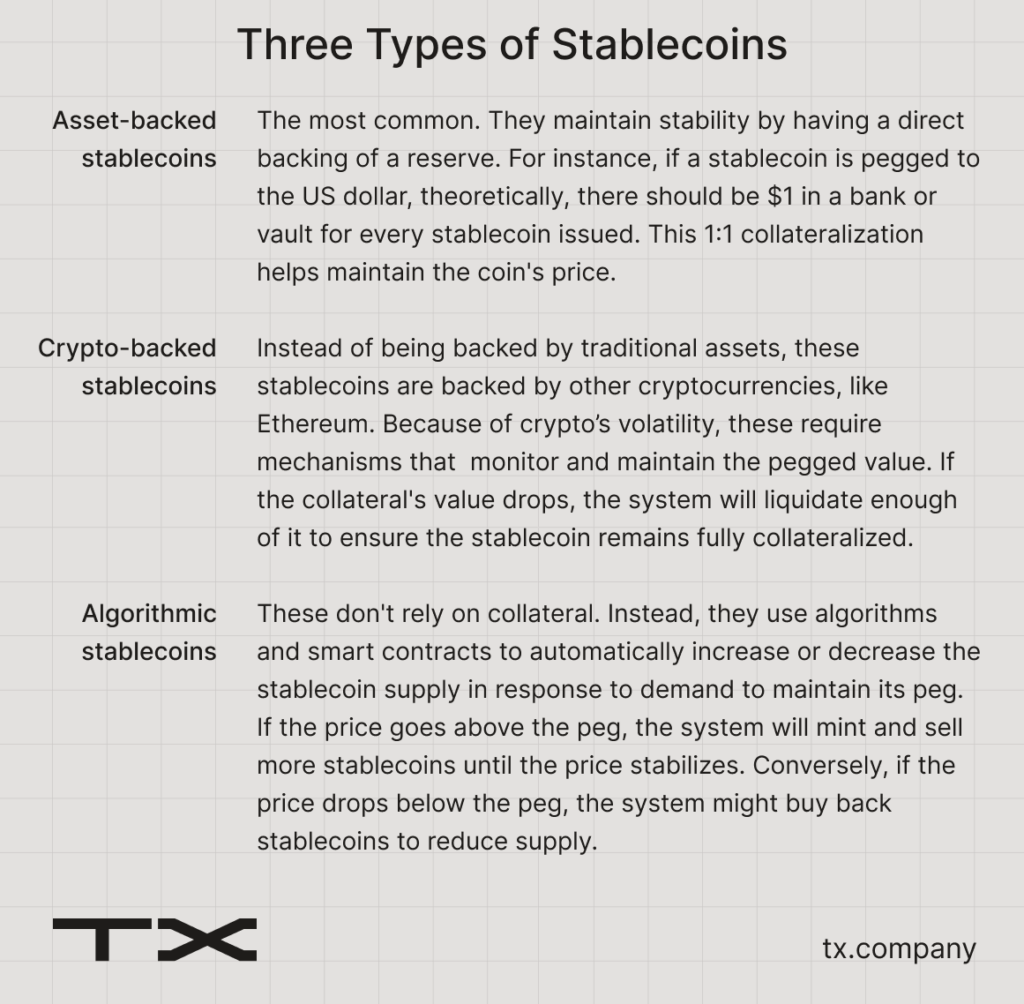2023-11-01

Marketing Lead at TX
Decentralized Finance, or DeFi, is an alternative to the traditional financial system that promises to become more accessible, transparent, and efficient. In this guide, we’ll go through the fundamentals of DeFi, its key components, and real-world applications. Let’s dive in!
In this article
Disclaimer: What you’re about to read is purely informational and isn’t meant to be financial advice. It’s important to do your own research and consult a qualified financial expert before making any decisions. Remember to keep things smart and informed!
The Fundamentals of Decentralized Finance
Decentralized Finance utilizes blockchain technology and smart contracts to provide various financial products and services. DeFi services aim to create decentralized, transparent, and accessible ecosystems that are faster, safer, and more economical than traditional finance systems and technologies. But what sets DeFi apart from the current financial landscape?
The backbone of DeFi is made up of smart contracts, which are self-executing agreements that enable complex financial transactions with cryptocurrency assets. These smart contracts, combined with the decentralized nature of blockchain technology, allow users to experience the benefits of DeFi without relying on centralized financial institutions.
Imagine having the power to access capital and financial services directly, without the need for banks or intermediaries – that’s the promise of DeFi.
This section covers the fundamentals of DeFi: blockchain technology, smart contracts, and the contrasts between centralized and decentralized systems. Understanding these critical concepts will enhance your understanding of DeFi’s potential to transform industries.
Blockchain technology
Blockchain technology is the foundation upon which DeFi is built, providing a secure, decentralized ledger for transactions and data storage. Blockchains enable digital ledgers that can be shared and updated by all participating network members (nodes), enabling different transactions within the DeFi ecosystem. But how can something as simple as a connected series of blocks be so secure?
The answer lies in the unique structure of the blockchain. Each block is connected to the previous one through the information contained within it, making it virtually impossible to alter earlier blocks without affecting subsequent ones. This level of security is further enhanced by encryption and the fact that once a block is written, its contents cannot be changed in any way. It’s this secure and decentralized nature that allows blockchain technology to create trust among members without a central authority or governing party, like a bank.
Smart contracts
Smart contracts are the secret sauce that makes DeFi transactions possible. These self-executing agreements automate actions based on predefined conditions, enabling trustless transactions and interactions within the DeFi ecosystem. Instead of relying on a central authority or intermediary to enable a transaction, smart contracts are programmed to carry out the financial transaction outlined in the smart contract.
Using smart contracts in DeFi offers a great deal of security and transparency. They are published on a blockchain, and all transactions are recorded, allowing anyone to verify them without revealing their identity. From automatically buying or selling tokens to facilitating complex financial transactions, smart contracts are the driving force behind the DeFi revolution.
Moving from centralized to decentralized systems
At the heart of the DeFi movement lies a fundamental shift from a centralized financial system to a decentralized system. While centralized systems rely on intermediaries and third parties to function, decentralized systems empower individuals through peer-to-peer networks and direct transactions. This decentralization not only eliminates the need for intermediaries but also allows users to access capital and financial services directly, bypassing traditional banks and financial institutions.
Decentralized platforms offer several advantages over their centralized counterparts, including those in the realm of centralized finance. For example, they are not subject to the same risks of bankruptcy or adversity faced by centralized institutions. Furthermore, the decentralized nature of DeFi platforms allows users to remain in control of their private cryptographic encryption keys, ensuring greater custody of their cryptocurrency assets.
Nonetheless, it’s essential to acknowledge the challenges accompanying the transition from centralized to decentralized systems. Centralized systems have long provided a consistent user experience, backed by regulatory oversight and robust consumer protections. While DeFi offers enhanced transparency and democratization, it sometimes lacks the centralized checks and customer support that many consumers have come to expect.
The components of DeFi ecosystems
The DeFi ecosystem is a growing space with various components that work together to provide a wide range of financial services. Some of the key components include decentralized exchanges (DEXs), lending platforms, and stablecoins. Each component plays a crucial role in enabling users to trade, invest, and access financial services within the DeFi ecosystem.
Decentralized exchanges (DEXs)
Decentralized exchanges, or DEXs, are platforms designed to streamline the process of trading cryptocurrencies by allowing users to transact directly with each other, bypassing the need for any middlemen or intermediaries. By doing so, DEXs afford users a higher degree of control over their assets and ensure a secure trading environment.
Unlike traditional exchanges, where assets are held by a third party during transactions, DEXs allow users to maintain ownership of their digital assets from start to finish. Furthermore, DEXs operate on a “non-custodial” basis, meaning they don’t hold onto users’ funds. Instead, all trades are executed directly between the users’ wallets.
Lending platforms
Lending platforms connect borrowers and lenders and enable users to earn interest on their assets or borrow funds using cryptocurrency as collateral. These platforms leverage blockchain technology to facilitate peer-to-peer lending, reducing the need for banks and similar intermediaries.
Lending platforms like Compound and Aave have gained popularity in the DeFi space for their innovative approach to borrowing and lending. Users can choose the money market they want to lend to and earn interest based on the market’s yield. By participating in lending protocols, users may be able to generate passive income and contribute to the growth of the chosen decentralized finance ecosystem.
There are also more specialized lending platforms like Silta, where infrastructure developers can access liquidity for their projects, and investors can connect with opportunities in the sustainable infrastructure domain, making a stride toward filling the global financing gap for sustainable infrastructure projects.
Stablecoins
Stablecoins play a vital role in the decentralized finance ecosystem by providing price stability, which is essential for smooth transactions and reducing volatility. These cryptocurrencies are pegged to a stable asset like the US dollar or gold, ensuring their value remains relatively constant over time.
The purpose of stablecoins is to combine the best aspects of traditional currencies (such as stability and trust) with the benefits of cryptocurrencies (like fast transactions and decentralization in some cases). Here’s a simplified breakdown of how they function:
- Asset-backed stablecoins: These are the most common. They maintain their stability by having a direct backing of a reserve. For instance, if a stablecoin is pegged to the US dollar, theoretically, there should be $1 in a bank or vault for every stablecoin issued. This 1:1 collateralization helps maintain the coin’s price.
- Crypto-backed stablecoins: Instead of being backed by traditional assets, these stablecoins are backed by other cryptocurrencies, like Ethereum. Because of the volatile nature of crypto, these require a mechanism that constantly monitors and maintains the pegged value. If the collateral’s value drops, the system will liquidate enough of it to ensure the stablecoin remains fully collateralized.
- Algorithmic stablecoins: These don’t rely on collateral. Instead, they use algorithms and smart contracts to automatically increase or decrease the stablecoin supply in response to demand to maintain its peg. If the price goes above the peg, the system will mint and sell more stablecoins until the price stabilizes. Conversely, if the price drops below the peg, the system might buy back stablecoins to reduce supply.

However, it’s worth noting that while they aim to be stable, they aren’t immune to fluctuations or potential risks, especially those not fully collateralized or dependent on complex algorithms. Always ensure you understand the mechanisms behind any stablecoin before using or investing in it. For example, the algorithmic stablecoin Terra Luna was eventually deemed a fraud after its meltdown in 2022.
Examples of decentralized finance in action
Some common services under the decentralized finance umbrella include yield farming, allowing users to earn returns on their assets, and prediction markets, which facilitate decentralized betting on the outcomes of events. Let’s take a brief look at how they function.
Yield farming
Yield farming allows users to gain passive income by providing liquidity to DeFi platforms and participating in various incentive programs. In essence, it enables users to increase returns on their investment by strategically allocating their assets across different DeFi protocols and earning interest on deposits and fees from trading.
Yield farming strategies can vary widely, with some users focusing on high-yield, high-risk opportunities while others opt for more conservative approaches. Here’s a simple overview of how yield farming works:
- Lending: You lend your cryptocurrency (like Ether) to a DeFi platform.
- Earning interest: In return, you receive interest on your lent assets.
- Liquidity pools: Often, you’re not just lending; you’re adding your assets to a pool that others can borrow or trade from.
- Rewards: For providing liquidity, you might get additional tokens as rewards, increasing your overall returns.
So, you might have some Ether (ETH) and decide to lend it on a DeFi platform. You add your ETH to a liquidity pool, and in return, you get interest and perhaps some bonus tokens. The yield is the total earnings (interest + bonus tokens) you get from your initial assets.

Prediction markets
Prediction markets enable users to speculate on the outcome of events. These markets operate on decentralized platforms, allowing participants to create and trade prediction contracts that pay out based on the accuracy of the prediction.
Decentralized prediction markets offer a unique approach to forecasting, as they rely on the collective intelligence of the crowd rather than traditional methods and experts. The prediction markets roughly work like this:
- Betting on Outcomes: Users bet on the outcomes of certain events (e.g., election results, weather forecasts, etc.).
- Buying Shares: You buy shares of the outcome you predict. If your prediction is correct, your shares will be worth more; if not, they may be worth less or nothing.
- Settling the Market: Once the event occurs, the market is settled, and if your prediction is correct, you make a profit.
Risks and challenges in DeFi
Like any other financial instrument, DeFi has its risks involving regulatory uncertainty, security concerns, and market volatility. Users need to understand and navigate these challenges to make the most of the opportunities that DeFi presents.
Regulatory uncertainty
Regulation changes or enforcement actions can significantly impact DeFi operations and the value of associated tokens. As such, users must stay informed about the regulatory environment and be prepared to adapt their strategies accordingly. Regulatory changes don’t happen overnight, so follow the news for topics that are brought to the legislators’ desks.
Security concerns
Security is a paramount concern in the decentralized finance space, with smart contract vulnerabilities and hacking incidents posing significant risks to the industry. For example, DeFi protocol Platypus has been a part of three hacks in 2023, amounting to millions of losses.
Individual users may have little power to prevent hacks on the chosen service provider. However, as this article has already underlined, be vigilant with where you place your assets, monitor them regularly, and take any necessary precautions you feel appropriate.

Market volatility
Market volatility and fluctuations in cryptocurrency prices can have a significant impact on the stability and value of DeFi investments. Abrupt changes in asset values can make it difficult to accurately price and value DeFi products, leading to increased risk and uncertainty for users.
To mitigate the impact of market volatility, users can employ various strategies such as:
- Hedging: Strategically using financial instruments like options or stablecoins to offset potential losses in your primary assets.
- Diversification: Spreading your assets to reduce the risk of a single investment failing.
- Staying invested: maintaining your position over the long term, riding out market fluctuations with the expectation that values may increase eventually.
- Active risk management: monitoring and actively adjusting your portfolio to mitigate potential losses during market volatility.
By adopting these approaches, users can better navigate the volatile DeFi landscape and protect their crypto assets from sudden market shifts.
Summary
The emergence of decentralized finance presents a promising alternative to traditional financial systems, offering increased accessibility, transparency, and efficiency. By leveraging blockchain technology and smart contracts, DeFi enables users to take control of their assets, engage in peer-to-peer transactions, and explore a range of financial services without intermediaries.
However, it’s crucial to approach this space with a discerning eye, understanding the associated risks such as regulatory uncertainties, security concerns, and market volatility. For anyone eager to dive into DeFi, it’s vital to stay informed, actively manage risks, and continually explore the ever-evolving landscape of decentralized applications and services.
If you’re looking to learn more about Web3 technology, check out our blog post on decentralized applications (dApps)!
Drop us a message to discuss your project
We’ll get back to you as soon as possible.
Find out more
For information on how we can transform your sector or business, please get in touch using the contact details below.





